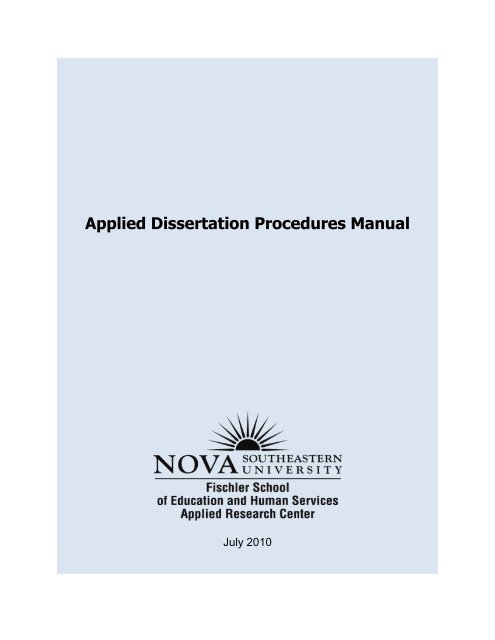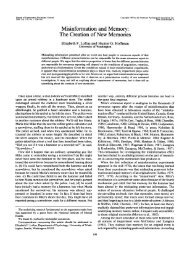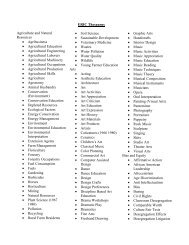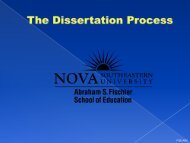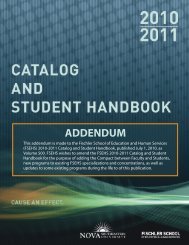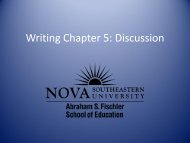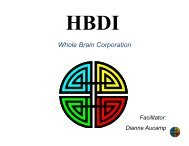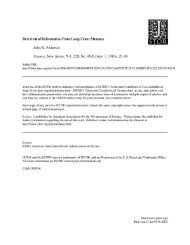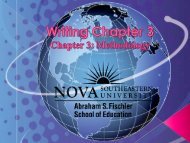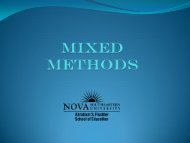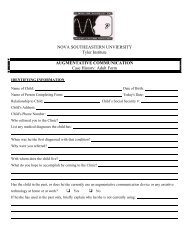Applied Dissertation Procedures Manual - 1 - Nova Southeastern ...
Applied Dissertation Procedures Manual - 1 - Nova Southeastern ...
Applied Dissertation Procedures Manual - 1 - Nova Southeastern ...
Create successful ePaper yourself
Turn your PDF publications into a flip-book with our unique Google optimized e-Paper software.
<strong>Applied</strong> <strong>Dissertation</strong> <strong>Procedures</strong> <strong>Manual</strong><br />
July 2010
Contents<br />
Purpose .............................................................................................................................................1<br />
Definition of an <strong>Applied</strong> <strong>Dissertation</strong> ..............................................................................................1<br />
Recommended Research and Methods for an <strong>Applied</strong> <strong>Dissertation</strong> ...............................................1<br />
Interventions, Developmental Research, and Program Evaluation .................................................2<br />
The Doctoral Program 2<br />
Concentration Areas...................................................................................................................2<br />
<strong>Applied</strong> <strong>Dissertation</strong> Services ....................................................................................................3<br />
Minors ........................................................................................................................................3<br />
Electives .....................................................................................................................................3<br />
Research Courses .......................................................................................................................3<br />
The <strong>Dissertation</strong> Committee 4<br />
Assignment of <strong>Dissertation</strong> Committee .....................................................................................4<br />
Communication Protocol ...........................................................................................................4<br />
Role of the Doctoral Student......................................................................................................5<br />
Role of the Committee Chair .....................................................................................................6<br />
Role of the Committee Member ................................................................................................6<br />
Student Access to ADRIANA (ARC <strong>Dissertation</strong> Services Database) 6<br />
<strong>Dissertation</strong> Student Request System ........................................................................................7<br />
Procedure for Requesting a Change of Committee Chair ..........................................................7<br />
Procedure for Addressing Other Issues......................................................................................7<br />
Selecting an <strong>Applied</strong> <strong>Dissertation</strong> Topic 7<br />
Texts ...........................................................................................................................................7<br />
Courses .......................................................................................................................................8<br />
Literature ...................................................................................................................................8<br />
Conferences and Workshops......................................................................................................8<br />
<strong>Dissertation</strong> Benchmarks, Credits, and Submission <strong>Procedures</strong> 9<br />
Concept Paper (ARC 8966, 2 Credits) .......................................................................................9<br />
Description ...............................................................................................................9<br />
Submission <strong>Procedures</strong> ............................................................................................9<br />
Proposal (ARC 8967, 5 Credits), ARC Review, and IRB Submission .....................................9<br />
Description ...............................................................................................................9<br />
Submission <strong>Procedures</strong> for ARC Review ................................................................9<br />
Submission <strong>Procedures</strong> for IRB Review................................................................10<br />
Final Report (ARC 8968, 5 Credits) and Final Approval ........................................................10<br />
Description .............................................................................................................10<br />
Submission <strong>Procedures</strong> ..........................................................................................10
<strong>Applied</strong> <strong>Dissertation</strong> Format and Templates .................................................................................10<br />
<strong>Dissertation</strong> Editors and Typists ....................................................................................................11<br />
Publishing Your <strong>Dissertation</strong> .........................................................................................................11<br />
References ......................................................................................................................................12<br />
Figure<br />
Communication Protocol for the Doctoral Student and the <strong>Dissertation</strong> Committee ................5<br />
Appendices<br />
A Frequently Asked Questions<br />
B Completion Checklist for Your <strong>Applied</strong> <strong>Dissertation</strong><br />
C ARC <strong>Dissertation</strong> Proposal Assessment Form<br />
D Sample Template for the Concept Paper, Proposal, and Final Report
1<br />
<strong>Applied</strong> <strong>Dissertation</strong> <strong>Procedures</strong> <strong>Manual</strong><br />
Purpose<br />
The purpose of this manual is to assist doctoral students as they move through the dissertation<br />
process at the Fischler School of Education and Human Services at <strong>Nova</strong> <strong>Southeastern</strong><br />
University (NSU). You will find in this manual the recommended sequence of courses and<br />
dissertation activities, the role of the dissertation committee, and an explanation of the<br />
benchmarks required to complete the doctorate. The doctoral research courses and all<br />
dissertation activities are under the purview of the <strong>Applied</strong> Research Center (ARC).<br />
Definition of an <strong>Applied</strong> <strong>Dissertation</strong><br />
Through the years, Fischler School students who received the doctoral degree typically<br />
investigated problems connected with the workplace; thus, the final products have been applied<br />
dissertations. Other than that distinction, Fischler School applied dissertations are similar to<br />
dissertations found at other universities. The applied dissertation study should follow the<br />
scientific method and should contribute to the literature in your concentration area.<br />
The applied dissertation entails a series of independent writing and research activities (with<br />
supervision) following the tenets of the scientific method. Thus, the applied dissertation is a<br />
process that concludes with a product. The process will require you to identify a research<br />
question or set of questions in your work setting or field of interest and employ the scientific<br />
method to conduct an appropriately designed study to address your research question or<br />
questions.<br />
The general steps in the scientific method are to (a) identify a problem, (b) review the related<br />
literature, (c) specify the purpose (and research questions), (d) collect data, (e) analyze and<br />
interpret the data, and (f) evaluate and report the findings. Initially, the introductory research<br />
course (EDD 9300: Methods of Inquiry) will help you develop the research foundation for your<br />
applied dissertation. Your dissertation committee will then guide you through a synthesis of your<br />
research and advise you in developing a relevant and significant study.<br />
Recommended Research and Methods for an <strong>Applied</strong> <strong>Dissertation</strong><br />
Students can utilize experimental, quasi-experimental, or non-experimental research for their<br />
dissertations. The research can be either quantitative, qualitative, or mixed methods. The<br />
following are examples that are considered acceptable for an applied dissertation:<br />
Quantitative Methods Qualitative Methods Mixed Methods<br />
Correlational Case Study Triangulation<br />
Survey Ethnographic Embedded<br />
Within-Subjects Grounded Theory Explanatory<br />
Between-Subjects<br />
Narrative Research
2<br />
Interventions, Developmental Research, and Program Evaluation<br />
An intervention-based research approach combined with one of the ARC-recommended research<br />
methods may be used for the applied dissertation, but an intervention is not a requirement. If<br />
utilized, the implementation process of an intervention must include the assessment of its<br />
relevant outcomes.<br />
Developmental research is defined as a method of examining definable trends or observing<br />
existing phenomena over an extended period of time. Due to the time constraints of doctoral<br />
studies, this type of research is not recommended. Developmental research is not to be confused<br />
with program development. Developing and/or evaluating a program (i.e., program evaluation) is<br />
acceptable only if the scientific method is employed (i.e., collect data, analyze, report findings),<br />
and it includes a relevant research design (e.g., correlational predictive design, multiple group<br />
pre- and posttest design), that is based on a valid program evaluation model.<br />
For students utilizing evaluation research for their dissertations, we suggest implementing, at a<br />
minimum, the outcome evaluation stage (i.e., identify and assess the outcomes, short and long<br />
term) using any relevant outcome-based evaluation model. Again, it is important to note that, the<br />
appropriate research design should be embedded within the outcome evaluation stage<br />
(correlational or survey approaches are commonly used).<br />
An in-depth overview of these approaches and designs is covered in the first required research<br />
course, EDD 9300: Methods of Inquiry; the designs are derived from the Creswell (2008) text,<br />
Educational Research: Planning, Conducting, and Evaluating Quantitative and Qualitative<br />
Research. The major outcomes of the applied dissertation are to (a) utilize an appropriate<br />
research design, (b) employ the scientific method, and (c) demonstrate doctoral-level research<br />
and writing competencies.<br />
Concentration Areas<br />
The Doctoral Program<br />
Students enrolled in the doctoral program select one of 11 concentration areas:<br />
Educational Leadership<br />
Health Care Education<br />
Higher Education Leadership<br />
Human Services Administration<br />
Instructional Leadership<br />
Instructional Technology and<br />
Distance Education<br />
Organizational Leadership<br />
Nursing Education<br />
Reading<br />
Special Education<br />
Speech-Language Pathology (both SLPD and EdD<br />
programs)
3<br />
<strong>Applied</strong> <strong>Dissertation</strong> Services<br />
Students who have completed all doctoral course work in 2 years will register for ADS 8090:<br />
<strong>Applied</strong> <strong>Dissertation</strong> Services I for the three terms in Year 3. Students who have not completed<br />
course work will still be required to register for ADS. If the applied dissertation has not been<br />
completed by the 36th month in the program, the student must register for ADS 8091: <strong>Applied</strong><br />
<strong>Dissertation</strong> Services II. All doctoral students are subject to the Continuing <strong>Dissertation</strong> Services<br />
fee if they have not achieved final approval for their applied dissertation by the time they have<br />
completed their regular academic (course work) schedule. A student must be registered to<br />
receive services from the dissertation committee and ARC.<br />
Minors<br />
Students have the option to select a five-course minor (15 credits) as a part of their program. The<br />
13 minors are Adult Education, Autism, <strong>Applied</strong> Behavior Analysis, Brain-Based Leadership,<br />
Charter School Education Leadership, Community College Leadership, Conflict Resolution,<br />
Curriculum Development, Early Childhood Education, Gerontology, Human Resource<br />
Development, School Business Leadership, and Urban Education. Descriptions of each of these<br />
minors can be found in the Fischler School’s Catalog & Student Handbook.<br />
Electives<br />
Students who do not include an education minor in their program will take up to 15, 18, 21, or 24<br />
credits (depending on the concentration) of their choosing from the education minor areas, the<br />
concentration areas, and the research courses.<br />
Research Courses<br />
All students enrolled in the doctoral program take a minimum of nine semester hours (9 credits)<br />
of research courses. EDD 9300: Methods of Inquiry (6 credits), the first research course, is a<br />
requirement. All research courses are designed to aid students in planning, conducting, and<br />
writing their dissertation. Thus, students select research courses to learn about research methods<br />
they will use in their research activities and their dissertations. Following are the research<br />
courses offered in the doctoral program (refer to the Fischler School’s Catalog & Student<br />
Handbook for complete descriptions).<br />
EDD 9300: Methods of Inquiry–The initial research course introduces the various types of<br />
research and teaches students how to develop research problems to investigate for their<br />
dissertation. During this course, three certificate exercises must be completed: (a) Plagiarism; (b)<br />
Collaborative Institutional Training Initiative (CITI), the federal requirement for Institutional<br />
Review Board (IRB) submissions; and (c) Format and Style.<br />
ARC 8912: Statistical Methods–Collecting and managing data, tables, figures, descriptive<br />
statistics, inferential statistics, and hypothesis testing. Prerequisite–EDD 9300: Methods of<br />
Inquiry.
4<br />
ARC 8913: Program Evaluation–Planning and conducting a program evaluation; reporting<br />
evaluation results. Prerequisite–EDD 9300: Methods of Inquiry.<br />
ARC 8914: Educational Assessment–Educational measurement procedures for tests and other<br />
assessments. Prerequisite–EDD 9300: Methods of Inquiry.<br />
ARC 8915: Survey Research–Planning and conducting survey research. Prerequisite–EDD 9300:<br />
Methods of Inquiry.<br />
ARC 8916: Qualitative Research–Planning and conducting qualitative investigations.<br />
Prerequisite–EDD 9300: Methods of Inquiry.<br />
ARC 8917: Advanced Program Evaluation–Builds on ARC 8913 to include more extensive<br />
evaluation activities. Prerequisite–ARC 8913: Program Evaluation.<br />
ARC 8918: Advanced Statistical Methods–Builds on ARC 8912 to include additional univariate<br />
and multivariate procedures. Prerequisite–ARC 8912: Statistical Methods.<br />
ARC 8919: Single Subject Research–Design used mostly in special education research.<br />
Prerequisite–EDD 9300: Methods of Inquiry.<br />
ARC 8920: Mixed Methods Research–Conducting research investigations using both<br />
quantitative and qualitative research paradigms. Prerequisite–ARC 8912: Statistical Methods or<br />
ARC 8916: Qualitative Research.<br />
The <strong>Dissertation</strong> Committee<br />
Each doctoral student is assigned a doctoral committee that consists of a chair and member. This<br />
committee will guide the student through the dissertation process.<br />
Assignment of <strong>Dissertation</strong> Committee<br />
During the term in which the student takes EDD 9300: Methods of Inquiry, he or she is<br />
instructed to complete ARC <strong>Dissertation</strong> Match, an online survey (usually within the 10th week<br />
of the course). Likewise, adjunct and full-time faculty members eligible to serve on dissertation<br />
committees will take this survey. The responses to the survey help match a student’s background<br />
and research interests to a dissertation committee chair and a dissertation committee member.<br />
Communication Protocol<br />
The chart shown in the figure illustrates that the main avenue of communication for the student<br />
regarding the dissertation is with the committee chair. There is no direct communication between<br />
the student and the committee member. The committee member will communicate with the<br />
committee chair.
5<br />
Student<br />
<strong>Dissertation</strong><br />
Committee<br />
Chair<br />
<strong>Dissertation</strong><br />
Committee<br />
Member<br />
Figure . Communication protocol for the doctoral student and the dissertation committee.<br />
Role of the Doctoral Student<br />
Throughout the dissertation process, the student is expected to<br />
be enrolled in order to receive advising and other dissertation services.<br />
abide by the Fischler School Student Code of Conduct<br />
(http://www.schoolofed.nova.edu/fgshome/fgscatalogs.htm). The student must follow the<br />
highest standards of scholarly and intellectual integrity and honesty throughout the<br />
dissertation process. To this end, the student should submit only original, scholarly work<br />
that conforms to Fischler School policies on plagiarism and original work and to<br />
applicable laws and regulations (e.g., copyright laws).<br />
submit documents to the dissertation committee chair using Microsoft Word. If the<br />
dissertation chair uses the reviewing and tracking features in Microsoft Word, the student<br />
should become proficient with those features.<br />
submit work that conforms to Fischler School guidelines for format and style as<br />
described in the Style Guide for the <strong>Applied</strong> <strong>Dissertation</strong> found on the ARC website.<br />
use only an NSU account for any e-mail correspondence with the dissertation chair.<br />
maintain contact and communication with the dissertation chair at least once a month.<br />
understand that the working relationship between student and chair is unique and based<br />
on a trusting interaction between professionals. The student should contact the<br />
dissertation chair for clarification on points in questions concerning research and writing<br />
and for advice and information regarding the dissertation process.<br />
utilize the information received from the dissertation chair and member to make the<br />
recommended organizational, content, format, and style changes in the concept paper,<br />
dissertation proposal, and final report.<br />
inform the dissertation chair of any changes in position, address, and other contact<br />
information, as well as professional and personal changes that might affect the student’s<br />
progress.<br />
follow the policies and procedures established by the university’s IRB for research with<br />
human subjects and the regulations that the student’s own agency or institution may have<br />
concerning the protection of human subjects in research.<br />
be current with CITI certification.
6<br />
Role of the Committee Chair<br />
It is the role of the committee chair to encourage the student and to review and make<br />
recommendations on the work submitted for the applied dissertation. The committee chair is<br />
expected to<br />
maintain regular communication with the student (at least once a month).<br />
evaluate and provide written and oral feedback to the student regarding the development<br />
of the concept paper, dissertation proposal and IRB submission, and final report.<br />
provide feedback to the student within 10 business days after receipt of document<br />
submissions (or notify the student in this time frame if a delay is necessary).<br />
ensure that student submissions follow Fischler School guidelines for format and style as<br />
described in the Style Guide for the <strong>Applied</strong> <strong>Dissertation</strong>.<br />
maintain a professional and collaborative relationship with the student.<br />
assist the student in identifying resources, such as those for improving writing skills, that<br />
may help in the dissertation process.<br />
use only an NSU account for any e-mail correspondence with the student and member.<br />
record all correspondence and evaluations with the ARC by using the ADRIANA<br />
database.<br />
Role of the Committee Member<br />
The dissertation committee member interacts only with the dissertation chair. The committee<br />
member does not interact directly with the student. The dissertation committee member is<br />
expected to<br />
evaluate and provide written feedback to the dissertation chair regarding the development<br />
of the student’s concept paper, proposal and IRB submission, and final report.<br />
provide feedback within 10 business days after receipt of document submissions from the<br />
dissertation chair (or notify the chair in this time frame if a delay is necessary).<br />
use only an NSU account for any e-mail correspondence with the dissertation chair.<br />
ensure that student submissions follow Fischler School guidelines for format and style as<br />
described in the Style Guide for the <strong>Applied</strong> <strong>Dissertation</strong>.<br />
Student Access to ADRIANA (ARC’s <strong>Dissertation</strong> Services Database)<br />
The ADRIANA database is used to track the progress of Fischler School doctoral students<br />
through the dissertation process, to provide students with a dissertation support link, and to work<br />
as a depository to upload documents. Students may access ADRIANA through the ARC website<br />
and by logging in using the student’s NSU username and password.
7<br />
On the student’s home page, contact information is displayed on the left-hand side of the page. If<br />
any of this information is in error, only the student can make corrections. If any of the contact<br />
information is in error, the student must go to the NSU WebStar site to make the needed<br />
corrections. Also provided on the opening page is contact information for both the dissertation<br />
committee chair and member.<br />
<strong>Dissertation</strong> Student Request System<br />
At the top of ADRIANA’s opening page is a link to the <strong>Dissertation</strong> Student Request System<br />
(DSRS). The purpose of the DSRS is to provide dissertation students with access to a portal<br />
where descriptions of individual student problems and issues may be entered and then addressed.<br />
Within the DSRS, the dissertation student will be asked to enter the type of request, and a<br />
description of the problem. This request will then be recorded, addressed, tracked, and resolved.<br />
Procedure for Requesting a Change of Committee Chair<br />
If the interaction between the student and dissertation committee chair is no longer viable, the<br />
student may request reassignment to a new committee chair. However, in doing so, the student<br />
must understand that this action could result in the development of a new dissertation topic.<br />
A student’s request for a change of dissertation chair is made by using the DSRS. To approve the<br />
request, the ARC will need to know the nature and history of the circumstances and the name of<br />
the currently assigned committee chair.<br />
If the request for a new dissertation committee chair is granted, the student will be instructed to<br />
retake the online ARC <strong>Dissertation</strong> Match survey. The student and the newly assigned committee<br />
chair will be informed of the reassignment by e-mail.<br />
Procedure for Addressing Other Issues<br />
When difficulties arise or the student believes that questions have not been adequately addressed<br />
by the committee chair, the student may contact the ARC by communicating the issue or<br />
problem through the DSRS. Students may also utilize ADRIANA to update their contact<br />
information and to monitor their progress through the dissertation benchmarks.<br />
Selecting an <strong>Applied</strong> <strong>Dissertation</strong> Topic<br />
Identifying an appropriate applied dissertation topic with related research questions is probably<br />
the most difficult task in the dissertation process. This activity requires insight, a strong literature<br />
background, and creativity. A number of resources are suggested here to help the student in this<br />
aspect of the dissertation journey.<br />
Texts<br />
Along with this procedures manual, the following text should prove helpful to the doctoral<br />
student in identifying the research problem, developing the proposal, conducting the research,<br />
and writing the final report: Educational Research: Planning, Conducting, and Evaluating<br />
Quantitative and Qualitative Research (Creswell, 2008). This text is required in the first research
8<br />
course (EDD 9300: Methods of Inquiry). Of particular importance in the Creswell text are<br />
Chapter 3 (“Identifying a Research Problem”) and Chapter 5 (“Specifying a Purpose and<br />
Research Questions or Hypotheses”).<br />
Two texts that address the literature review and citing sources correctly (to avoid plagiarism) are<br />
Writing Literature Reviews: A Guide for Students of the Social and Behavioral Sciences (Galvan,<br />
2005) and Using Sources Effectively: Strengthening Your Writing and Avoiding Plagiarism<br />
(Harris, 2005). These texts are required for EDD 9200: Trends and Issues, the first course taken<br />
by Fischler School doctoral students.<br />
Courses<br />
In doctoral courses, students are exposed to many ideas that can transcend into an appropriate<br />
topic for the applied dissertation. This exposure should prove to be useful in courses the student<br />
takes in the concentration area, in the introductory research course (EDD 9300: Methods of<br />
Inquiry), and in other research courses (particularly, ARC 8912: Statistical Methods and ARC<br />
8916: Qualitative Research).<br />
Literature<br />
Resources for the dissertation literature review must be scholarly in nature, relying heavily on<br />
empirically based, peer-reviewed primary sources. The Alvin Sherman Library at NSU offers<br />
over 300 databases that contain references to journal articles, books, conference papers,<br />
government documents, tests and measurements, and dissertations. Many items are available in<br />
full text, and students can order materials that are not available electronically by using Document<br />
Delivery Services.<br />
Librarians at the Alvin Sherman Library offer assistance in conducting literature searches in a<br />
variety of modalities, including instruction sessions during the EDD 9300: Methods of Inquiry<br />
course; via a toll-free number, e-mail, and chat sessions; at the Summer Conference; and in<br />
person. Visit the Alvin Sherman Library website (http://www.nova.edu/library/main) for more<br />
information.<br />
Conferences and Workshops<br />
Students are required to attend a Summer Conference. Students have the opportunity at the<br />
Summer Conference to meet face to face with their assigned committee chairs and to attend<br />
workshops and training sessions related to all aspects of the applied dissertation.<br />
Regional dissertation workshops are offered to all doctoral students at various locations<br />
throughout the United States. At these dissertation workshops, Fischler School doctoral students<br />
have the opportunity to attend sessions related to the applied dissertation and to meet one on one<br />
with Fischler School faculty and staff who are knowledgeable about specific aspects of the<br />
dissertation process.<br />
Students may also attend professional conferences in their chosen field that will be valuable in<br />
identifying potential dissertation topics. At conferences, students should attend research paper
9<br />
and poster presentation sessions and meet and interact with experienced researchers as they<br />
present the results of their investigations.<br />
<strong>Dissertation</strong> Benchmarks, Credits, and Submission <strong>Procedures</strong><br />
In completing the applied dissertation requirement, students must sequentially pass three<br />
benchmarks totaling 12 credits. Benchmarks are graded as “pass” or “fail”; however, the grade is<br />
not posted until the benchmark has been approved. A “pass” grade can be recorded only when<br />
the full committee has approved the benchmark. An entry of “PR” is posted at the end of each<br />
term for benchmarks that are not completed but in which progress is substantiated.<br />
Completion of a particular benchmark is not a requirement for registration for a subsequent level;<br />
students, in some cases, may be simultaneously registered for all three benchmarks. Students can<br />
work with their chairs utilizing the sample timeline provided in Appendix B. A description of<br />
each of the three dissertation benchmarks follows.<br />
Concept Paper (ARC 8966, 2 Credits)<br />
Description. The concept paper is typically 10-12 pages in length, presents the student’s<br />
proposed research agenda, and represents the first three chapters of the dissertation. To meet this<br />
benchmark, the concept paper must receive full committee approval, after which the committee<br />
chair posts a grade.<br />
Submission procedures. The student submits the concept paper electronically to the<br />
committee chair as an attachment using Microsoft Word and e-mail. The chair reviews the<br />
submission, and after careful review and multiple iterations, forwards the document to the<br />
committee member for review.<br />
Proposal (ARC 8967, 5 Credits), ARC Review, and IRB Submission<br />
Description. The proposal builds on the concept paper and represents the first three<br />
chapters of the applied dissertation (including the problem, a review of the literature, and the<br />
methodology). The literature review in Chapter 2 of the Proposal must be exhaustive. Most<br />
literature reviews contain, at a minimum, 30 references from recent peer-reviewed research<br />
articles. Exhaustive literature reviews usually exceed 25-30 pages in length. To meet this<br />
benchmark, the proposal must receive full committee approval. Students are highly encouraged<br />
to use NSU Library Help to conduct a comprehensive search for recent published articles.<br />
Submission procedures for ARC review. Once the student receives preliminary<br />
approval from his or her dissertation committee, the proposal should be sent (by the student) to<br />
the ARC for review. The submission is completed through an online procedure located on the<br />
student page of ADRIANA. The ARC will review the proposal utilizing an electronic assessment<br />
form (see Appendix C). The student and dissertation committee will receive feedback from the<br />
ARC; if additional changes are required after the review the student should work with his or her<br />
committee, address the deficiencies, and resubmit the proposal. After receiving approval, the<br />
student can move forward to the IRB review process.
10<br />
Submission procedures for IRB review. After receiving ARC approval, the dissertation<br />
committee will submit an approval date in ADRIANA. Next, the committee chair (named coinvestigator<br />
on the IRB submission) will direct the student to submit the study for IRB approval.<br />
The submission is completed through an online procedure located in ADRIANA. Approval by<br />
the IRB to conduct research is a federal requirement for the protection of human subjects. Before<br />
any dissertation research is conducted (i.e., collecting data), the student must have a recent CITI<br />
certificate and IRB approval.<br />
Final Report (ARC 8968, 5 Credits) and Final Approval<br />
Description. The final applied dissertation report includes the research plan and design<br />
(as described in the first three chapters of the proposal and IRB submission), followed by the<br />
Results section (Chapter 4) and the Discussion section (Chapter 5). Refer to Appendix A for<br />
answers to specific questions related to the final report.<br />
Submission procedures. After receiving a recommendation of the final report from the<br />
dissertation committee, the student submits the applied dissertation manuscript to the ARC for<br />
final approval. The steps in the final-approval process are described at the ARC website. Final<br />
approval includes the following: content review by an ARC program professor, format review by<br />
ARC staff, and the approval of the executive dean. The ARC will notify the student of the final<br />
approval. The notification will include instructions for the paper and electronic manuscript<br />
copies and for signatures on the approval page.<br />
<strong>Applied</strong> <strong>Dissertation</strong> Format and Templates<br />
All doctoral course assignments, as well as the concept paper, the proposal, and the final report,<br />
should conform to the format and style guidelines found in the Style Guide for the <strong>Applied</strong><br />
<strong>Dissertation</strong> and the sixth edition of the Publication <strong>Manual</strong> of the American Psychological<br />
Association (APA, 2010).<br />
To become familiar with APA style, students should study Mastering APA Style: Student’s<br />
Workbook and Training Guide (Gelfand, Walker, & APA, 2010). This reference is used in<br />
conjunction with the Format and Style Exercises, a requirement of the introductory research<br />
course, EDD 9300: Methods of Inquiry.<br />
A template has been developed for the preliminary pages and for chapter format and content to<br />
aid students in producing documents consistent with the required guidelines. The sample<br />
template displaying the topics, sequence, and suggestions for successful completion of the<br />
concept paper is located in Appendix D.
11<br />
<strong>Dissertation</strong> Editors and Typists<br />
Students are expected to study the Fischler School guidelines (including APA style) for format<br />
and style from the beginning of their academic program. Any student who is having difficulty in<br />
the preparation of the applied dissertation manuscript should discuss the issue with his or her<br />
committee chair.<br />
Students who hire an editor or typist should provide that person with the Style Guide for the<br />
<strong>Applied</strong> <strong>Dissertation</strong>. Editors must be proficient in the application of APA style to a dissertation<br />
manuscript. Editors and typists must communicate with the student and not with university<br />
personnel. The university does not assume responsibility for a student’s contractual agreement<br />
with an editor or typist or for the quality of work and turnaround time. The ARC does not<br />
employ dissertation editors or typists, nor can it recommend specific editors or typists.<br />
An editor or typist should not send a manuscript to the ARC. It is the student’s responsibility to<br />
ensure that the applied dissertation is correct prior to submission. Editors and typists must not<br />
make changes that affect the content of the applied dissertation; they must not assist in<br />
conducting the investigation or writing the report (but correction of grammar and syntax is<br />
permissible). Refer to the ARC website for advice about finding a capable editor or typist.<br />
Publishing Your <strong>Dissertation</strong><br />
Fischler School dissertations are made available on an NSU library database. To disseminate<br />
their results on a wider basis, students should submit the applied dissertation to the ProQuest<br />
<strong>Dissertation</strong>s and Theses database. The electronic version of the approved applied dissertation is<br />
submitted by the ARC to the MARPs, Practicums, and <strong>Applied</strong> <strong>Dissertation</strong>s database of the<br />
NSU library. Only individuals with valid NSU identification numbers have access to this<br />
database.<br />
To publish the applied dissertation through the ProQuest database, students may find complete<br />
instructions at the ProQuest website (http://il.proquest.com/dissertationagree). For the username,<br />
type dissertations; for the password, type publish. Materials for the ProQuest database should not<br />
be sent to the Fischler School or the ARC. If you have any questions about the submission<br />
process, call ProQuest at 1-800-521-0600, extension 7020.
12<br />
References<br />
American Psychological Association. (2010). Publication manual of the American Psychological<br />
Association (6th ed.). Washington, DC: Author.<br />
Creswell, J. W. (2008). Educational research: Planning, conducting, and evaluating quantitative<br />
and qualitative research (3rd ed.). Upper Saddle River, NJ: Pearson.<br />
Galvan, J. L. (2005). Writing literature reviews: A guide for students of the social and<br />
behavioral sciences (3rd ed.). Glendale, CA: Pyrczak.<br />
Gelfand, H., Walker, C. J., & The American Psychological Association. (2010). Mastering APA<br />
style: Student’s workbook and training guide. Washington, DC: American Psychological<br />
Association.<br />
Harris, R. A. (2005). Using sources effectively: Strengthening your writing and avoiding<br />
plagiarism (2nd ed.). Glendale, CA: Pyrczak.
Appendix A<br />
Frequently Asked Questions<br />
Q – Should I include the survey or scale that I used for my study in the appendices?<br />
A - Copyrighted material should not be included in the appendices without permission. Authors<br />
of survey instruments often give permission to use a survey in a study but not necessarily to<br />
include it in the dissertation manuscript. Forms, questionnaires, test instruments, and documents<br />
that you produced for the study should be included in the appendix section. Refer to the<br />
Publication <strong>Manual</strong> of the American Psychological Association for additional information<br />
relating to appendix material and to the Fischler School’s Style Guide for the <strong>Applied</strong><br />
<strong>Dissertation</strong> for format requirements.<br />
Q – Should I be concerned with issues pertaining to copyright?<br />
A- Yes, in general, every student is responsible for ensuring that the doctrine of fair use under<br />
the U.S. copyright law is observed. The author of an applied dissertation is responsible for<br />
ensuring that the use of any previously copyrighted material in the manuscript beyond fair use<br />
has the written permission of the copyright owner. In general, fair use allows an author to quote<br />
excerpts from copyrighted work if the excerpts do not constitute a major portion of the original<br />
work and if a full reference with a citation is included in the text. Purchased tests or<br />
measurement instruments should never be included without specific and written permission from<br />
the copyright owner. When in doubt, seek permission. For additional information pertaining to<br />
copyright, see Copyright Law & Graduate Research by Kenneth D. Crews<br />
(http://www.umi.com/en-US/products/dissertations/copyright/).<br />
Q – I submitted a letter to the IRB from the individual providing approval for me to conduct<br />
research in a school or organizational system. Should I include this in the appendices?<br />
A- No, do not include this letter anywhere in the dissertation. The letter is kept on file at the IRB<br />
office.<br />
Q – How should I refer to my school, agency, or organization in the dissertation where I’m<br />
conducting research?<br />
A – Refer to the setting in general terms (e.g., “the research was conducted at a high school in<br />
south Georgia”). When referring to a school or organization do not use pseudo names, such as<br />
“School A” and “University X.”<br />
Q – Should I cite documents from internal sources at my work setting?<br />
A – No, do not cite the information in a formal manner. Only refer to the school or organization<br />
using general descriptions within the text.
Q – What should I write in the dissertation’s abstract?<br />
A – Refer to section 2.04 of the Publication <strong>Manual</strong> of the American Psychological Association<br />
for a description of appropriate content and to the Fischler School’s Style Guide for the <strong>Applied</strong><br />
<strong>Dissertation</strong> for format requirements.<br />
Q – Does the dissertation title require specific content or a particular number of words?<br />
A – Refer to section 2.01 of the Publication <strong>Manual</strong> of the American Psychological Association<br />
for guidelines pertaining to a concise and fully explanatory title. The manual’s word-length<br />
recommendation (12 words or fewer) is intended mainly for manuscript’s submitted to journals;<br />
the dissertation title may be slightly longer.
Appendix B<br />
Completion Checklist for Your FSEHS <strong>Applied</strong> <strong>Dissertation</strong><br />
Name:_______________________________________ Date:_________________<br />
Steps to Complete<br />
Check if Anticipated<br />
Complete Completion<br />
Notes<br />
Concept Paper<br />
Capstone Completed for MOI<br />
Merge Problem and Purpose (Ch 1)<br />
Expand Literature Review (Ch 2)<br />
Complete Research Questions (Ch 2)<br />
Expand Methods (Ch 3)<br />
Submit Initial CP to Chair<br />
Revise and Resubmit<br />
Concept Paper Approved<br />
Proposal<br />
Complete Introduction (Ch 1)<br />
Complete Literature Review (Ch 2)<br />
Complete Methodology (Ch 3)<br />
Write Intro Pages (e.g., Abstract)<br />
Submit Initial Proposal to Chair<br />
Revise and Resubmit<br />
ARC Review<br />
Revise and Resubmit<br />
Proposal Approved<br />
IRB<br />
Obtain Administration Letter<br />
Pass CITI<br />
Obtain Instruments and Measures<br />
Create Flyers & Recruitment Materials<br />
Draft Consent and/or Assent Forms<br />
Complete Submission Form<br />
Obtain Chair Approval & Signature<br />
Submit to IRB<br />
Revise and Resubmit<br />
IRB Approved<br />
Final Report<br />
Collect Data<br />
Analyze Data<br />
Write Results (Ch 4)<br />
Finish Discussion (Ch 5)<br />
Finalize APA and FSEHS Style<br />
Finalize Intro Pages (e.g., Abstract)<br />
Finish Reference Section<br />
Finish Appendices<br />
Change First 3 Chapters to Past Tense<br />
Submit AD to Chair<br />
Revise and Resubmit<br />
Submit for Final Review<br />
Revise and Resubmit<br />
<strong>Applied</strong> <strong>Dissertation</strong> Approved
Appendix C<br />
ARC <strong>Dissertation</strong> Proposal Assessment Form<br />
1. Is the Problem Statement clear and representative of the proposed study?<br />
Yes or No. If No, Provide Details<br />
2. Does the Literature Review reflect the Problem Statement?<br />
Yes or No. If No, Provide Details<br />
3. Is the Literature Review Exhaustive?<br />
Yes or No. If No, Provide Details<br />
4. Are the Research Questions adequate (clear, feasible, and measurable)?<br />
Yes or No. If No, Provide Details<br />
5. Does the Methodology accurately reflect the proposed Research Questions?<br />
Yes or No. If No, Provide Details<br />
6. Does the Methodology include an appropriate research approach and design?<br />
Yes or No. If No, Provide Details<br />
7. Are the general steps in the Scientific Method to be employed (i.e., identify a problem,<br />
review the related literature, specify the purpose, collect data, analyze and interpret the data,<br />
and evaluate and report the findings).<br />
Yes or No. If No, Provide Details<br />
8. Is the proposal a doctoral-level study?<br />
Yes or No. If No, Provide Details<br />
9. Does the proposal follow FSEHS guidelines (i.e., correct style and format; template used)?<br />
Yes or No. If No, Provide Details<br />
General comments regarding the overall proposal will be provided here (e.g., the study<br />
contributes to the field)
Appendix D<br />
Sample Template for the Concept Paper, Proposal, and Final Report<br />
Directions<br />
The following template has been developed specifically to help the doctoral student format and<br />
type the dissertation document to comply with the writing and style guidelines of the APA<br />
Publication <strong>Manual</strong> (6th ed.) and the Fischler School’s <strong>Applied</strong> Research Center. The template<br />
includes the sections needed for the final dissertation report that are not needed for the concept<br />
paper or proposal. In creating the document, use only the sections indicated (√) in the following<br />
chart.<br />
Sections of Template Used for <strong>Dissertation</strong> Benchmark Submissions<br />
Template Section Concept Paper Proposal Final Report<br />
Cover Page √ √ √<br />
Approval Page * * √<br />
Abstract * √ √<br />
Table of Contents * √ √<br />
Chapters √ (1-3) √ (1-3) √ (1-5)<br />
* These sections may be included as part of the concept paper and proposal but should be blank.<br />
Note. The complete MS Word template can be downloaded from the ARC website.
[Insert Title Here]<br />
Comment [e1]: Titles should be brief yet<br />
informative, and should reflect the problem, the<br />
solution strategies, and the age range of those<br />
involved (if appropriate). The title should begin with<br />
a noun signifying some form of action such as<br />
“Development of …,” “Evaluation of …,” and<br />
“Formation of …” Appropriate title words may be<br />
"solving,” "increasing," "reducing," or "improving."<br />
A sample title page appears in the Style Guide for<br />
the <strong>Applied</strong> <strong>Dissertation</strong> (SGAD).<br />
by<br />
[Insert Name Here]<br />
An <strong>Applied</strong> <strong>Dissertation</strong> Submitted to the<br />
Fischler School of Education and Human Services<br />
in Partial Fulfillment of the Requirements<br />
for the Degree of Doctor of Education<br />
Comment [e2]: The concept paper’s length,<br />
excluding title page and references, should be about<br />
10 to 12 pages. The concept paper includes Chapters<br />
1, 2, and 3. It can be considered an abbreviated<br />
version of the Proposal and follows the same format<br />
as the Proposal.<br />
Comment [e3]: The Final Report will include<br />
Chapters 4 and 5.<br />
<strong>Nova</strong> <strong>Southeastern</strong> University<br />
[Enter Year Here]
Approval Page<br />
This applied dissertation was submitted by [INSERT NAME] under the direction of the<br />
persons listed below. It was submitted to the Fischler School of Education and Human<br />
Services and approved in partial fulfillment of the requirements for the degree of Doctor<br />
of Education at <strong>Nova</strong> <strong>Southeastern</strong> University.<br />
Comment [e4]: This page may be included in the<br />
concept paper and proposal, without signatures, but<br />
it must be included in the final report.<br />
[INSERT NAME AND DEGREE, e.g., Al Smith, EdD] Date<br />
Committee Chair<br />
[INSERT NAME AND DEGREE]<br />
Committee Member<br />
Date<br />
Program Professor Review<br />
<strong>Applied</strong> Research Center<br />
Date<br />
Dana Scott Mills, PhD<br />
Executive Dean<br />
Date
Abstract<br />
[INSERT TITLE OF DISSERTATION]. [INSERT NAME, e.g., Richard Dadier, 2010]:<br />
<strong>Applied</strong> <strong>Dissertation</strong>, <strong>Nova</strong> <strong>Southeastern</strong> University, Fischler School of Education and<br />
Human Services. [INSERT 4 or 5 ERIC DESCRIPTORS, e.g., ERIC Descriptors:<br />
Databases, Internet, Media Selection, Middle Schools, Teacher Education]<br />
Comment [e5]: The Abstract doesn’t have to be<br />
completed until the final report. An abbreviated<br />
Abstract is recommended for the proposal. Leave a<br />
blank page for the concept paper and leave only the<br />
heading “Abstract.”<br />
[INSERT DESCRIPTION OF DISSERTATION- Example Follows]: This applied<br />
dissertation was designed to provide better access to current information for the students<br />
and staff in a middle school. The printed materials located in the school’s media center<br />
were outdated, scarce, or inadequate. Electronic databases were available in the media<br />
center for online searching and information retrieval. However, the students did not know<br />
how to use databases as a source for completing class assignments or how to browse<br />
within these online services to find additional information. Teachers also did not know to<br />
use electronic information to enrich their lessons.<br />
The writer developed lesson plans and strategies to train students and teach on how two<br />
online services available in the media center. Daily sessions on these databases provided<br />
students and teachers with training in (a) e-mail usage, (b) searching and locating current<br />
events information, (c) printing from the screen, (d) saving messages, and (e) dialing into<br />
the online services. Teachers were encouraged to continue to use these services for<br />
curriculum enrichment and as an additional source for future lesson plans.<br />
An analysis of the data revealed that students were more likely than teachers to use the<br />
online databases. The most successful activities were those that involved students in<br />
research information about current events. Although teachers planned assignments that<br />
required the use of online services, they did not want to provide additional time for<br />
students to be in the media center.
Table of Contents<br />
Page<br />
Chapter 1: Introduction ........................................................................................................1<br />
Xxxxxxxxxxx xx Xxxxxxxxx ..................................................................................1<br />
Xxxxxxxx Xxxx Xxxxxx .........................................................................................2<br />
Xxxxxxxx Xxxxx .....................................................................................................4<br />
Comment [e6]: Leave Table of Contents in the<br />
document and fill in and complete for the final<br />
report. You do not have to complete sections here<br />
until the Final <strong>Dissertation</strong> Report. Guidelines for<br />
formatting the Table of Contents are contained in the<br />
SGAD.<br />
Chapter 2: Literature Review ...............................................................................................6<br />
Xxxxxxx Xxxxxxxxx ...............................................................................................6<br />
Xxxxxx Xxxxxxxxxxx .............................................................................................9<br />
Xxxxxx xx xxx Xxxx .............................................................................................11<br />
Xxxxxxxxxxxx xx xxx Xxxxxxx xx xxx Xxxxxxxx .............................................14<br />
Chapter 3: Methodology ....................................................................................................24<br />
Xxxxxx ...................................................................................................................24<br />
Xxxxxxxx Xxxxxxxx .............................................................................................25<br />
Xxxxxxxxxxx xx Xxxxxxxx ..................................................................................27<br />
Chapter 4: Results ..............................................................................................................29<br />
Xxxxxxxxxx xxx Xxxxxxxxx xx Xxxxxxxxx .......................................................29<br />
Xxxxxxxxxxx xx Xxxxxxx Xxxxxxxxx ................................................................39<br />
Xxxxxx xx Xxxxxx Xxxxxx ................................................................................. 43<br />
Comment [e7]: Concept paper and proposal will<br />
contain Chapters 1-3. Concept paper is considered an<br />
abbreviated version of the proposal and follows the<br />
same format.<br />
Chapter 5: Discussion ........................................................................................................46<br />
Xxxxxxxx ...............................................................................................................46<br />
Xxxxxxxxxx ...........................................................................................................50<br />
Xxxxxxxxxxxxxxx .................................................................................................54<br />
Xxxxxxxx xx Xxxx ................................................................................................57<br />
References ..........................................................................................................................59<br />
Appendices<br />
A Title in Initial Caps and Lower Case—Begin a Second Line Directly Below<br />
the First Line ...................................................................................................60<br />
B Title in Initial Caps and Lower Case .............................................................62<br />
Tables<br />
1 Title in Initial Caps and Lower Case ..............................................................10<br />
2 Title in Initial Caps and Lower Case ..............................................................48<br />
Figure<br />
Title in Initial Caps and Lower Case .....................................................................47
Statement of the Problem<br />
Chapter 1: Introduction<br />
This should include (a) a clear statement that the problem exists, (b) evidence that<br />
supports the existence of the problem, (c) evidence of an existing trend that has led to the<br />
problem, (d) definitions of major concepts and terms (this can be provided below in a<br />
sub-section), (e) a clear description of the setting, (f) probable causes related to the<br />
problem, and (g) a specific and feasibly statement. Specific subtopics may include the<br />
following.<br />
The topic. This is a brief description of the proposed area of study.<br />
The research problem. This is an area of conflict, concern, or controversy (a gap<br />
between what is wanted and what is observed).<br />
Comment [e8]: APA Level 1 heading. Do not<br />
adjust the format of the listed headings.<br />
Comment [e9]: According to the SGAD,<br />
SINGLE SPACE after all punctuation throughout the<br />
document.<br />
Comment [e10]: Starting in Chapter 1 the<br />
document should be double-spaced, with 12-point<br />
Times New Roman or Courier New type face. See<br />
SGAD and APA manuals for complete details.<br />
Comment [e11]: APA Level 2 heading<br />
Comment [e12]: APA Level 3 heading. Writing<br />
starts after the period for Level 3 headings.<br />
Background and justification. Provide evidence from the literature and<br />
experience showing that the problem exists and the relevance. Include at least two<br />
references.<br />
Deficiencies in the evidence. Include a brief discussion that details the area of<br />
need in relation to the problem and the deficiency or lack of evidence in the literature.<br />
Audience. Discuss who is affected and who benefits.<br />
Definition of Terms<br />
Term or variable. Provide the complete scientific definition and appropriate<br />
reference if necessary. Include as many terms or variables as needed.<br />
Purpose of the Study<br />
“The purpose statement should provide a specific and accurate synopsis of the<br />
overall purpose of the study” (Locke, Spirduso, & Silverman, 1987, p. 5).<br />
Key points to keep in mind when preparing a purpose statement are as follows:<br />
1. Create a sentence that begins with “The purpose of this study is . . .”<br />
2. Clearly identify and define the central concepts or ideas of the study.
Chapter 2: Literature Review<br />
The literature review should be built from the annotated bibliography assignment<br />
from EDD 9300 and should contain the following elements: (a) a discussion of the<br />
theoretical or conceptual framework within which the study will be grounded; (b) a<br />
synthesis of the findings in a “state-of-knowledge” summary in regard to the problem<br />
area, including additional evidence as to the nature and the importance of the problem;<br />
(c) a clear discussion of how further research should extend, differ from, or replicate past<br />
studies, including the identification of critical variables in the problem area and important<br />
questions to be tested; (d) an indication of shortcomings that should be avoided in the<br />
design of prior research, as well as strengths to be repeated in conducting another study;<br />
and (e) a critique of the literature as a basis for any controversial methodological<br />
decisions to be presented in the proposal.<br />
Research Questions<br />
Comment [e13]: An abbreviated literature<br />
review is presented in the concept paper. Students<br />
taking EDD 9300 can build the lit review from their<br />
Annotated Bibliography. An exhaustive lit review<br />
should be presented in the proposal (to be<br />
exhaustive, a minimum of 30 pages with up to 30<br />
peer-reviewed articles).<br />
Comment [e14]: Indent the beginning of each<br />
paragraph with one touch of the Tab button (1/2 “).<br />
Comment [e15]: Various headings and<br />
subheadings can and should be used within the lit<br />
review<br />
The research questions are based on the problem or area of need and on the<br />
research reviewed. The research questions should adhere to the following guidelines: (a)<br />
formation of question or questions based on theory, previous research (i.e., the literature<br />
review), and experience; (b) stated in the form of a question; and (c) focused and clear<br />
(i.e., specific, feasible, and measurable).
Participants<br />
Chapter 3: Methodology<br />
Comment [e16]: Write this section in future<br />
tense because it is a proposal. Convert to past tense<br />
where appropriate once data have been collected.<br />
This section should include the following elements: (a) the target population or<br />
sample (to which it is hoped the findings will be applicable) should be defined,<br />
consistent with the Statement of the Problem and the Research Question(s) sections;<br />
(b) the population from which the sample will actually be drawn should be specified<br />
(this should also include demographic information such as age, gender, and ethnicity);<br />
and (c) procedures for selecting the sample should be outlined, including justification<br />
for the sampling method (i.e., sampling procedure).<br />
Instruments<br />
This section will detail each data-collection instrument. The relevant information<br />
pertaining to each instrument should include (a) the source or developers of the<br />
instrument, (b) validity and reliability information, and (c) other salient information (e.g.,<br />
number of items in each scale, subscales).<br />
<strong>Procedures</strong><br />
Design. The design is the actual structure or framework which provides the<br />
“when,” or time in which data will be collected (e.g., correlational approach with a<br />
predictive design). The specific type of design should be written in the first sentences of<br />
this section then followed up by the details of how the data will be collected (i.e., the<br />
methodological steps). Write this section in future tense. Convert to past tense where<br />
appropriate once data have been collected. The <strong>Procedures</strong> section is based directly on the<br />
research questions and the design of choice (i.e., this is the “how to” section of the<br />
examination) and should be written step by step in a linear fashion with a time line. Steps<br />
pertaining to the control of issues related to internal and external validity should be<br />
discussed here.<br />
Data analysis. Indicate the appropriate data analyses that will be used in the<br />
investigation. These data analyses should be based on the research questions and the<br />
research design selected for the study. Specify the procedures for reducing and coding the<br />
data. For quantitative studies, subsequent data analyses should include summary<br />
descriptive statistics and inferential statistical tests (e.g., independent or dependent t test,<br />
ANOVA, and chi-square). For qualitative studies, the procedures to be followed for the<br />
analyses must also be addressed.<br />
Limitations<br />
Include any limitations, restrictions, or constraints that may affect the validity<br />
(i.e., internal or external) of the dissertation’s outcome.
Chapter 4: Results<br />
results presented in sequence and relative to each research question<br />
only the results are presented without a rationale or discussion<br />
includes relevant tables and figures<br />
appropriate use of statistical or qualitative language to present data<br />
Comment [e17]: Chapter 4 should only be<br />
included for the final report and should include the<br />
elements listed here. Additional components and<br />
subheadings will be necessary and unique to your<br />
study (all written in past tense).
Chapter 5: Discussion<br />
introductory paragraphs provide overview of the study<br />
results are elaborated and interpreted in sequence and relative to each research<br />
question<br />
conclusions and summaries regarding the findings are offered<br />
findings are linked to relevant research<br />
implications of findings are discussed<br />
limitations are indicated<br />
recommendations for future research are offered<br />
Comment [e18]: The Discussion section should<br />
only be included for the Final <strong>Dissertation</strong> Report<br />
and should include the elements listed here.<br />
Additional subheadings will be required for this<br />
chapter that are unique to your study.
References<br />
Comment [e19]: All sources cited in text must<br />
appear in the References section and vice versa.<br />
Follow APA and SGAD guidelines.


